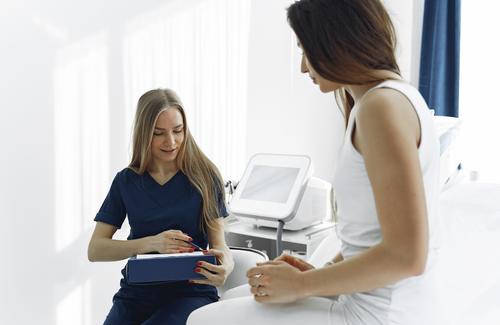
Key points
- Gonorrhoea can be passed on during anal, vaginal and oral sex.
- Using a condom during sex is an effective way of preventing gonorrhoea.
- Gonorrhoea is treated with a single dose combination of antibiotics.
Gonorrhoea is a common sexually transmitted infection. Gay men and young heterosexual men and women are the groups most affected by gonorrhoea in the UK. In recent years, the number of infections has been increasing in gay men. It was the second most common sexually transmitted infection diagnosed in gay men in 2018.
Gonorrhoea is caused by the bacterium Neisseria gonorrhoeae. Gonorrhoea can live in the anus, cervix, urethra, throat and, occasionally, the eyes.
You can become infected with gonorrhoea if you come into contact with infected semen or infected discharge from the vagina, throat or rectum. It can be passed on during anal, vaginal and oral sex, and by mouth-to-anus contact (rimming), if no condom is used.
It can also be passed on by sharing sex toys if they are not washed or covered by a new condom each time they are used. Infection can also spread from the vagina to the rectum via vaginal fluids. There are some studies suggesting gonorrhoea in the throat can be transmitted through kissing and using saliva as lubricant.
In a person with HIV who is not taking HIV treatment, untreated gonorrhoea may make them more infectious. This is because untreated sexually transmitted infections can increase HIV viral load in genital fluids. However, if the person with HIV is taking effective HIV treatment and has an undetectable viral load, they will not pass HIV on. Gonorrhoea will not make a difference to this.
In an HIV-negative person, having gonorrhoea can make acquiring HIV more likely if they come in to contact with the virus.
If you are pregnant, gonorrhoea can cause miscarriage or early labour. It can be passed on from mother to baby during childbirth, infecting the baby’s eyes. This can cause discharge and swelling and may result in blindness. If you are pregnant and may have gonorrhoea, it is important you are tested and treated before your baby is born.
Prevention
Using a condom for anal or vaginal sex, or a condom or dental dam (a sheet of latex) for oral sex, is an effective way of avoiding transmission of gonorrhoea.
Also, don’t share sex toys. If you do, wash them or cover them with a new condom before anyone else uses them.
People who are sexually active are advised to have regular sexual health check-ups, especially if you have recently had a new partner. It is recommended that people with HIV have a sexual health check at least once a year. There, you will be tested for gonorrhoea and other sexually transmitted infections. In some situations, having a check-up more often may be recommended, such as if you are having unprotected sex with new or casual partners. Gay men having unprotected sex – including oral sex – with new or casual partners are advised to have a sexual health check every three months. If you are thinking about becoming pregnant, it is advised you are tested for gonorrhoea.
In the UK, most HIV treatment centres have an associated sexual health clinic. These offer confidential and free treatment. You don't need to be referred by your GP or your HIV doctor.
Symptoms
Symptoms of gonorrhoea usually appear between two and ten days after acquiring the bacteria. However, for many people, especially women, there may only be very mild symptoms, no symptoms for many months, or none until the infection spreads to other parts of the body.
Gonorrhoea symptoms may include discharge from the genitals and burning sensation while passing urine. It is more common to have a discharge from the penis than the vagina. This discharge might be a thin and watery consistency with white, yellow or green colour. There are also less common symptoms such as pain and swelling in the testicles, pain or tenderness in the lower abdomen (most often in women) and bleeding between periods or heavier periods.
“A general sexual health check-up includes testing for gonorrhoea."
For trans men and women, symptoms may vary depending on whether they have had bottom surgery and the type of surgery.
If the infection is rectal, there may be no symptoms or, for both men and women, there may be a discharge from the anus and pain or discomfort in the anus.
Gonorrhoea in the throat usually causes no symptoms.
Infection in the eyes can cause pain, swelling, irritation and discharge (conjunctivitis).
If left untreated, gonorrhoea can cause more serious health problems. This includes pelvic inflammatory disease (PID), which is an infection in the upper part of the female reproduction system. It can cause long-term pelvic pain, infertility and ectopic pregnancy. Untreated gonorrhoea may also cause testicular problems and potentially reduce fertility.
If untreated, gonorrhoea can affect the joints, causing arthritic-like pain and swelling or skin rashes. It can eventually spread to the bloodstream, leading to serious infection (septicaemia), which can be life-threatening.
Diagnosis
A general sexual health check-up includes testing for gonorrhoea. You can also have a test at your GP (family doctor) surgery. Another option is for you to take your own swabs and samples and post them to a laboratory for analysis.
If you have symptoms such as genital discharge, it is best if a swab is taken from the cervix, entrance to the vagina or the tip of the penis by a doctor or nurse during an examination. If you do not wish to have an examination or you do not have any symptoms a urine sample may be tested.
Sometimes, swabs will also be taken from the throat, rectum and eye.
Some results for gonorrhoea may be available immediately from examining the urine sample or swabs. Other results will take longer, and you will be told when to contact the clinic for the outcome. It is important to do so, so you can be treated if gonorrhoea is diagnosed.
Treatment
Gonorrhoea can be easily treated with a single dose combination of antibiotics.
Many guidelines recommend a single dose of ceftriaxone – given by injection – and a single dose of azithromycin given as a tablet as the first-line treatment. In contrast, both the British Association of Sexual Health and HIV (BASHH) and the US Centers for Disease Control and Prevention (CDC) recommend a single ceftriaxone injection when there is no known antibiotic resistance.
Occasionally a second course of antibiotics is needed if your symptoms do not go away or you are found to have a strain of gonorrhoea resistant to those drugs. Some strains of gonorrhoea have substantial levels of resistance to a number of antibiotics, including penicillin, tetracyclines and ciprofloxacin. Advice is to avoid infection if possible, by following guidance on protected sex, testing and treatment.
It is very important not to have any sort of anal, oral or vaginal sex during this period as you may be re-infected with gonorrhoea or pass the infection to your partners.
It is possible to become infected with gonorrhoea again after being successfully treated. To avoid this, make sure any of your sexual partners have also been treated. Condoms, used properly and consistently, can prevent infection with gonorrhoea and many other sexually transmitted infections.

